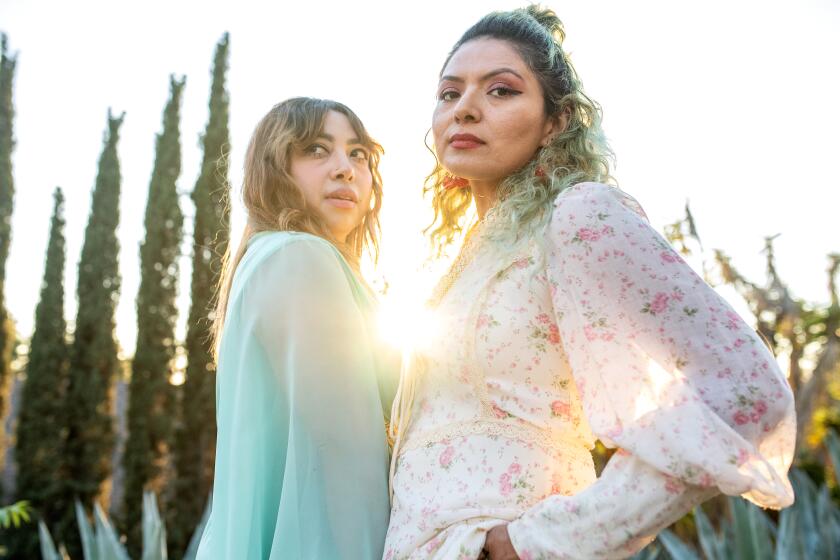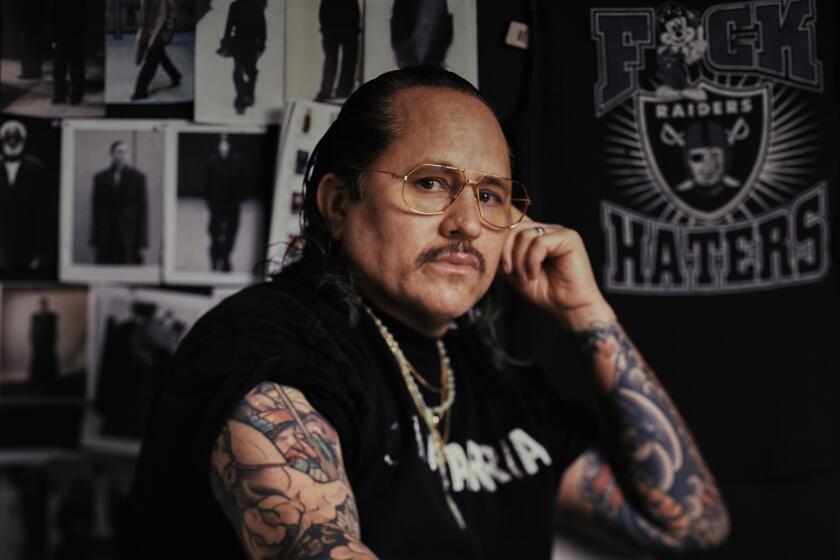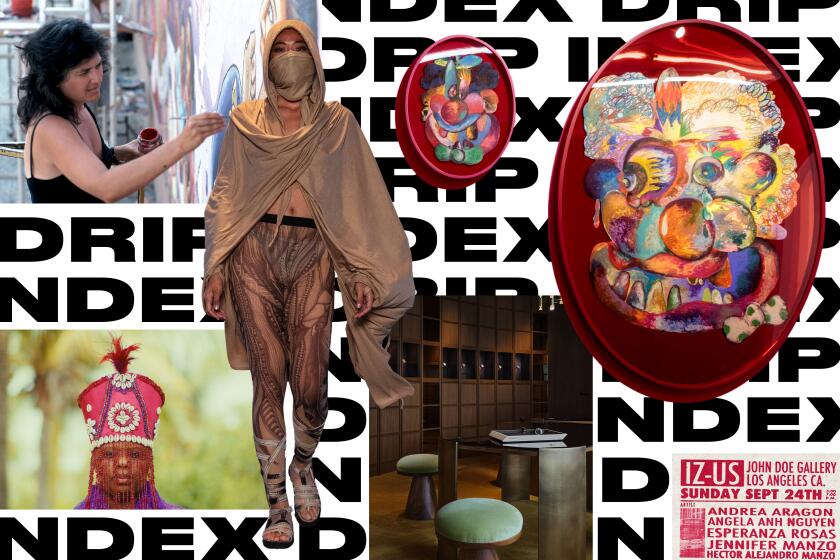- Share via

This story is part of Image issue 22, a meditation on the many definitions of the city’s favorite word: luxury. Read the whole issue here.
Walking into the vintage store James Veloria is like walking into a party at any time: Abundant silver tinsel, shag rugs, purple carpets, pink ceilings, heart-shaped doorways and wall-to-wall mirrors call to mind a funky birthday party or else a themed dance hall. Prismatic mesh Jean Paul Gaultier frocks and Vivienne Westwood corsets hang on the wall (alongside any and all things from the early aughts). But what also makes this celebrated vintage establishment unique is that it’s like walking into a museum. The owners, Collin James Weber and Brandon Veloria Giordano, might be vintage dealers, but they’re also fashion historians, cataloging modernity (and predicting trends) simply by pursuing what they think is interesting — and fun.
In my past life as a fashion stylist, I regularly borrowed pieces from their New York City store (especially lesser-known, older brands like Matsuda or JC de Castelbajac), which is located in a mall in Chinatown on East Broadway. Since 2017, James Veloria has featured rotating capsule collections — entire racks devoted to specific time periods in a designer’s career. I ran my hands over buttery silk button-downs in deep purple and lambent teal during a Tom Ford for Gucci capsule collection, and slipped into a cream column dress with a cutout at the hip. The dress was, alas, too long on me, but the point isn’t always to buy these exquisite artifacts. It’s to experience a little bit of fashion history, even if it means trying something on for a few minutes before returning it to the rack. Part of the thrill is also just reading the tags on each item in the store, which list the year and season that the item was released. These efforts provide customers with a chance to study, firsthand, the work of major designers’ artistic visions and how they have evolved over time.
Style is about channeling something from somewhere. The L.A. duo Sister Kokoro knows how to pull together the right threads
Earlier this fall, Weber and Giordano opened a pop-up store in L.A. in Lincoln Heights, which will remain open through Oct. 15. Unsurprisingly, they already have a fan base. “The pop-up was only supposed to last a month, but people have been so supportive and excited, we wanted to keep going with the energy,” Giordano explains. By the end of the year, Weber and Giordano will open a much-anticipated permanent shop, a space that the duo sees as filled with new possibilities. It’s safe to assume the new space will feature party-ready interiors, capsule collections and plenty more silver tinsel.
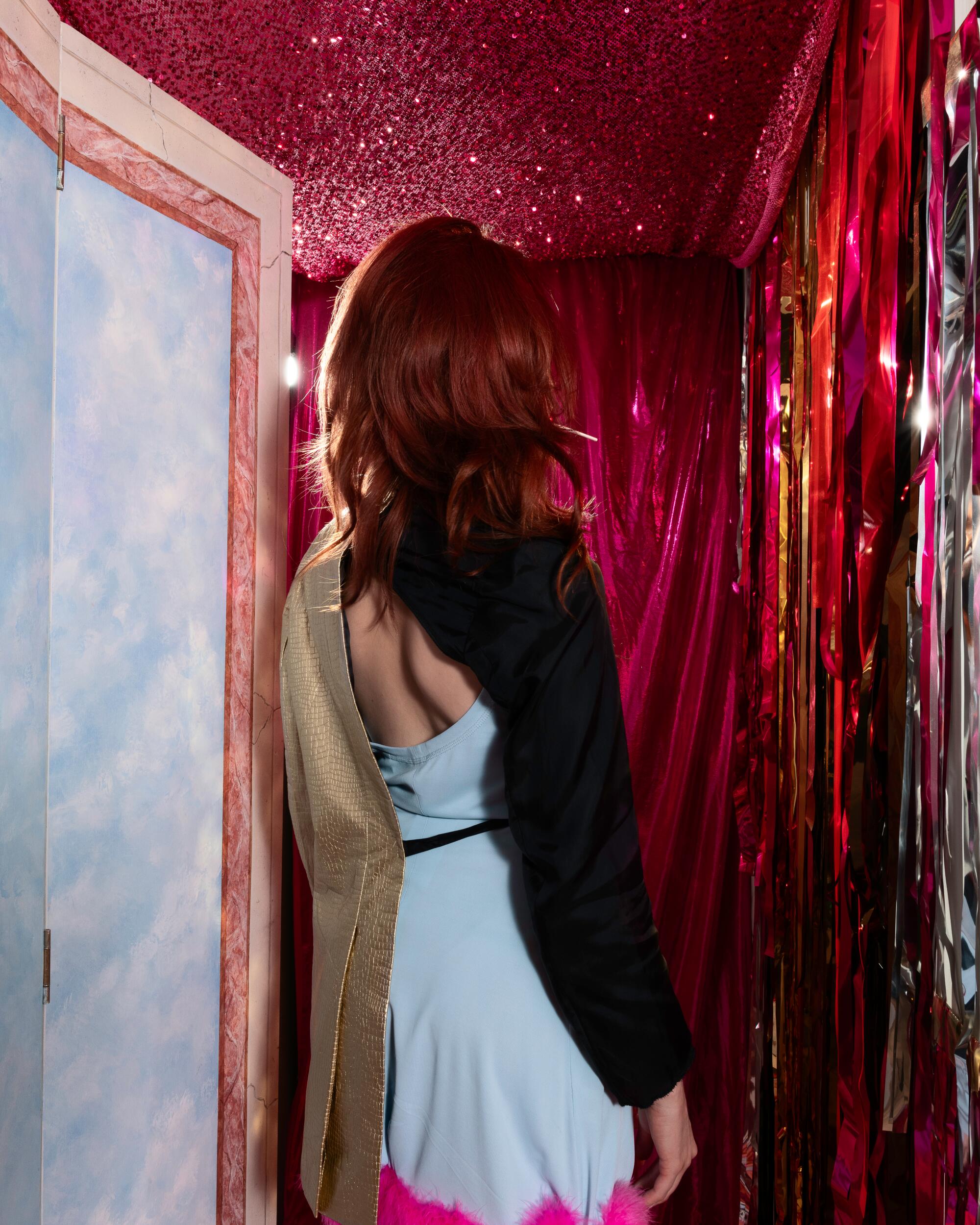
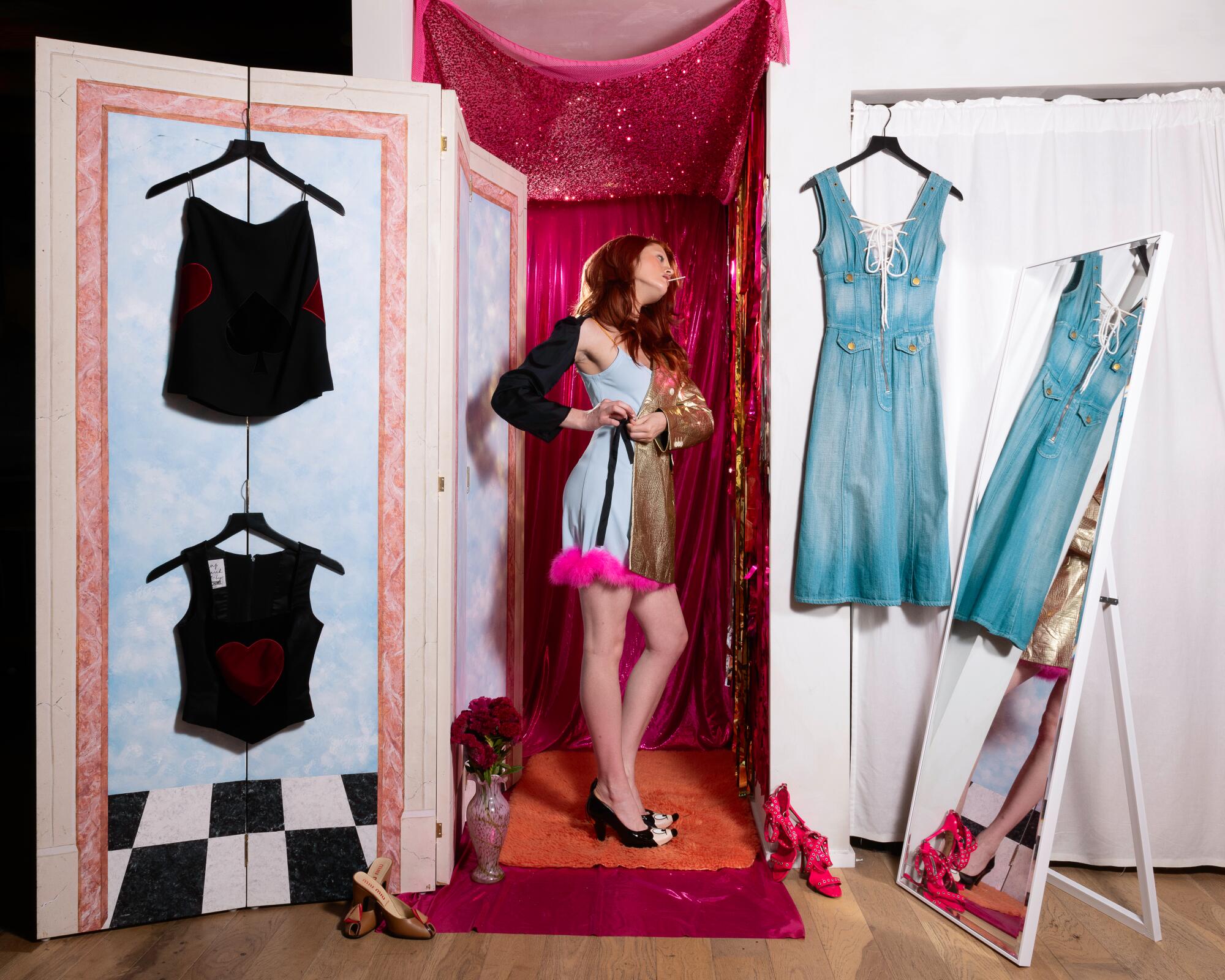
Eugenie Dalland: I want to start by sharing that I’m wearing a Vivienne Westwood Red Label dress from the spring/summer 1999 collection that I bought at James Veloria. If Vivienne had designed the costumes for “Fight Club,” this dress is what the character Marla would have worn. It looks like a ‘50s housewife stuck her finger in an electrical socket. Do films influence what you buy?
Brandon Veloria Giordano: The entire wardrobe in that movie is so inspiring! It definitely influences what I’m personally wearing, which then influences what’s in the store. When I think about “Fight Club,” I think about really low-rise pants with no underwear and maybe a little tank top. I was definitely buying that sort of stuff for a while.
Collin James Weber: We’ve been watching Almodóvar movies lately, which have such great clothes. Gaultier did some, Karl Lagerfeld did some. We got a little pink Chanel suit that was almost the same exact one that was in “High Heels” from 1991. For our store spaces, we always have Almodóvar on the mood board. The way that he uses color is incredible.
BVG: Being in L.A., it’s hard not to think about movies and costumes. The city itself is very inspiring in that way. “The Cook, the Thief, His Wife & Her Lover” from 1990 [by director Peter Greenaway] really inspired our current pop-up. The space is set up like the dining room in the film.
ED: I love that you mark price tags with the year and season that the garment or accessory is from. Why is it important to contextualize products in a historical fashion narrative?
CJW: Honestly a lot of it is just based on our own curiosity. Whenever we get a piece, we want to know when it’s from. We’ll have a rough idea based on the style of it, but it’s fun to dig around and do the research. There’s a lot of good resources of old runway imagery, ad campaigns, all sorts of things. I think we also felt a little self-conscious when we first started — many of the old-school dealers said, This stuff isn’t vintage, it’s only from 15 years ago. Do you even know what you have?
BVG: We still get that all the time.
The Taiwanese American artist’s designs are an antidote for a textile industry status quo that just talks the talk.
CJW: I think we wanted to prove to people that we knew what we had on our racks. That it didn’t matter if it was only 15 years old. We want people to know that these are special pieces, and they have a history to them, even if the reason they’re buying something is just because it fits great and they love it, which is totally great too.
BVG: For us, it’s like YAY! We get to share knowledge with you! We’re not trying to gatekeep this information.
ED: Right. Sometimes high-end vintage clothing dealers can be a little snobby.
CJW: Even when we came up with the name “James Veloria,” combining our middle names, it sounded so serious that we made the logo really kooky.
BVG: It sounded too rich! Like it would be a store on Madison Avenue.
CJW: So we literally made the logo look like a kid’s toy store.
BVG: The cartoons “Ah! Real Monsters” and “Rugrats” were my inspiration for designing the logo. Our website has that vibe too.
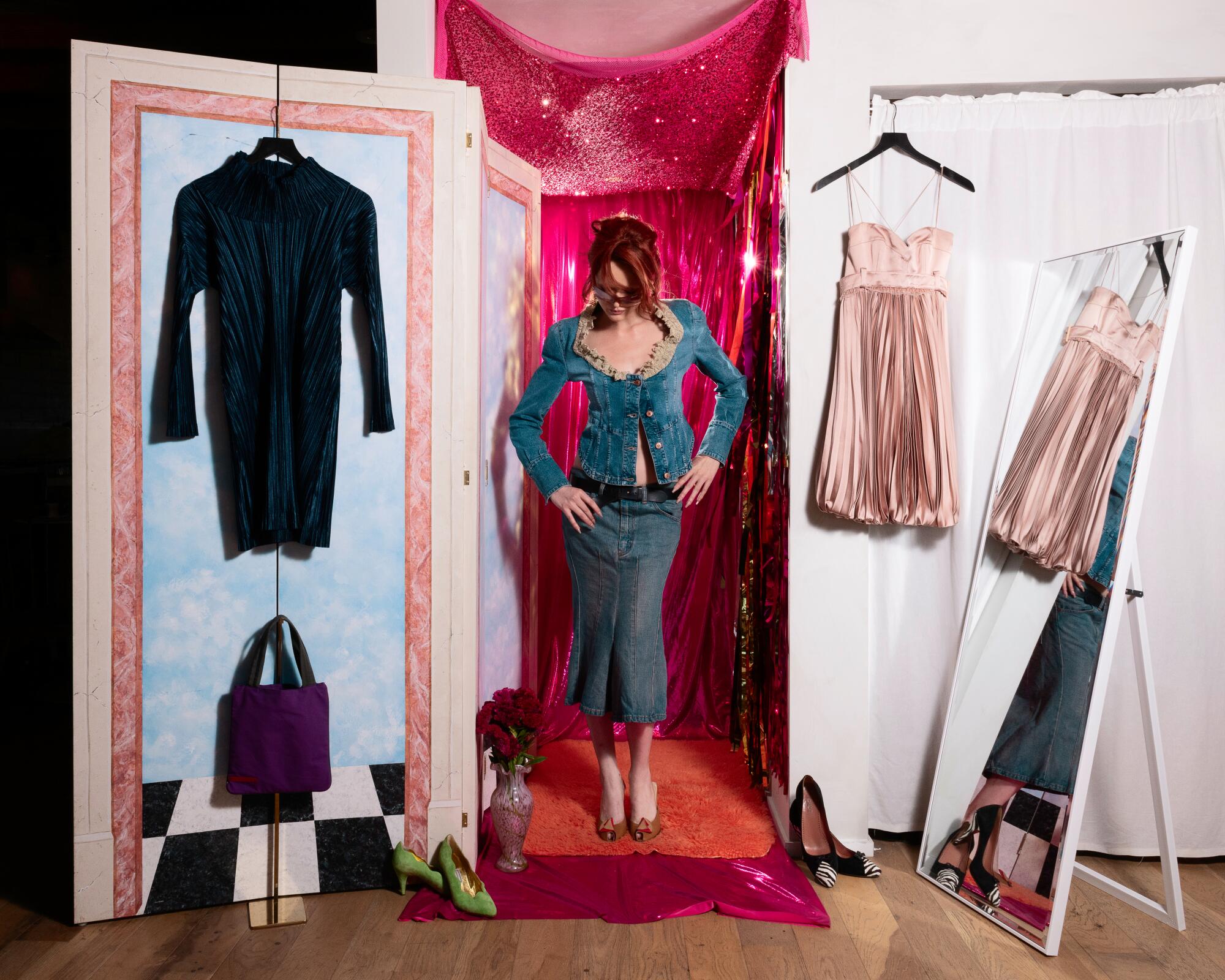


ED: Your designer capsule collections present a selection of pieces from a specific time period in a designer’s career. I feel like these capsules are a reflection of your desire to share knowledge in a really fun, engaging way. Can you tell me a bit about those? The first one was Prada Sport. Those pieces, from the late 1990s to early 2000s, were amazing.
BVG: The capsule collections are about sharing what we love with our customers. With the Prada Sport one, it was like, hey you should look at this time period of Prada because we think it’s cool and hopefully you’ll like it too!
CJW: It was a small collection, maybe 50 pieces. It was fun to see it all together. When you have so many pieces to compare, you learn so much. What did the bags look like, what did the shoes look like? Which runways were they in? What did the labels look like, and how did they change over time? Labels also help us to date pieces if we can’t find them in runway or ad campaign imagery.
ED: I especially love the collections that feature the work of specific designers when they were creative directors at other brands, like Michael Kors for Céline, Stella McCartney at Chloé, and Tom Ford for Gucci, all of which are from the 1990s through the 2000s. It’s like visiting the Costume Institute but you actually get to touch and purchase the clothes. How do you decide which designers to focus on for these capsules?
BVG: It again comes down to what we’re wearing, but also how your own style evolves. By the time we did the Michael Kors, I wasn’t wearing as much Gaultier. I wanted to be sexy and sleek and tan and look like I’m stepping off a helicopter, so Michael Kors’ Céline was the obvious choice! You just sort of hope that your customers will go along with that fantasy with you.
CJW: People really responded to those pieces, and he came in for it.
ED: Michael Kors came into the store?
BVG: Yeah, he’s so sweet and supportive. He talks to every customer, tells them he needs the outfits they’re wearing. Sometimes designers sneak in and out and don’t want to be noticed. But he loves it, he’s great. He talks to everyone.
‘No matter what I’m doing, you’ll always know where I’m from, my influences and my culture.’
CJW: Sometimes a capsule collection even starts with getting a single piece that we think is cool but don’t expect to be that popular and then everyone wants it, out of nowhere. We’ll put it on our Instagram stories and 50 people reply saying that they need it. Then we start to see what else we can find.
BVG: Some capsules are definitely easier to source than others. The Chloé by Stella stuff was really hard to find. It took a full year to collect 100-150 pieces.
ED: How do you source these collections?
CJW: We source from clients all over the city, online, and any thrift store we happen to walk past.
ED: Do you have a capsule planned for the new L.A. store?
BVG: We do. Something about being in L.A. made me want to turn into Donatella Versace! Blond, tan, the Italian accent, a woman who is totally inhabiting her power. People can say whatever the f— they want to say about her — but she is a smart designer and incredibly talented, and she makes clothes that people feel really f—ing hot in.
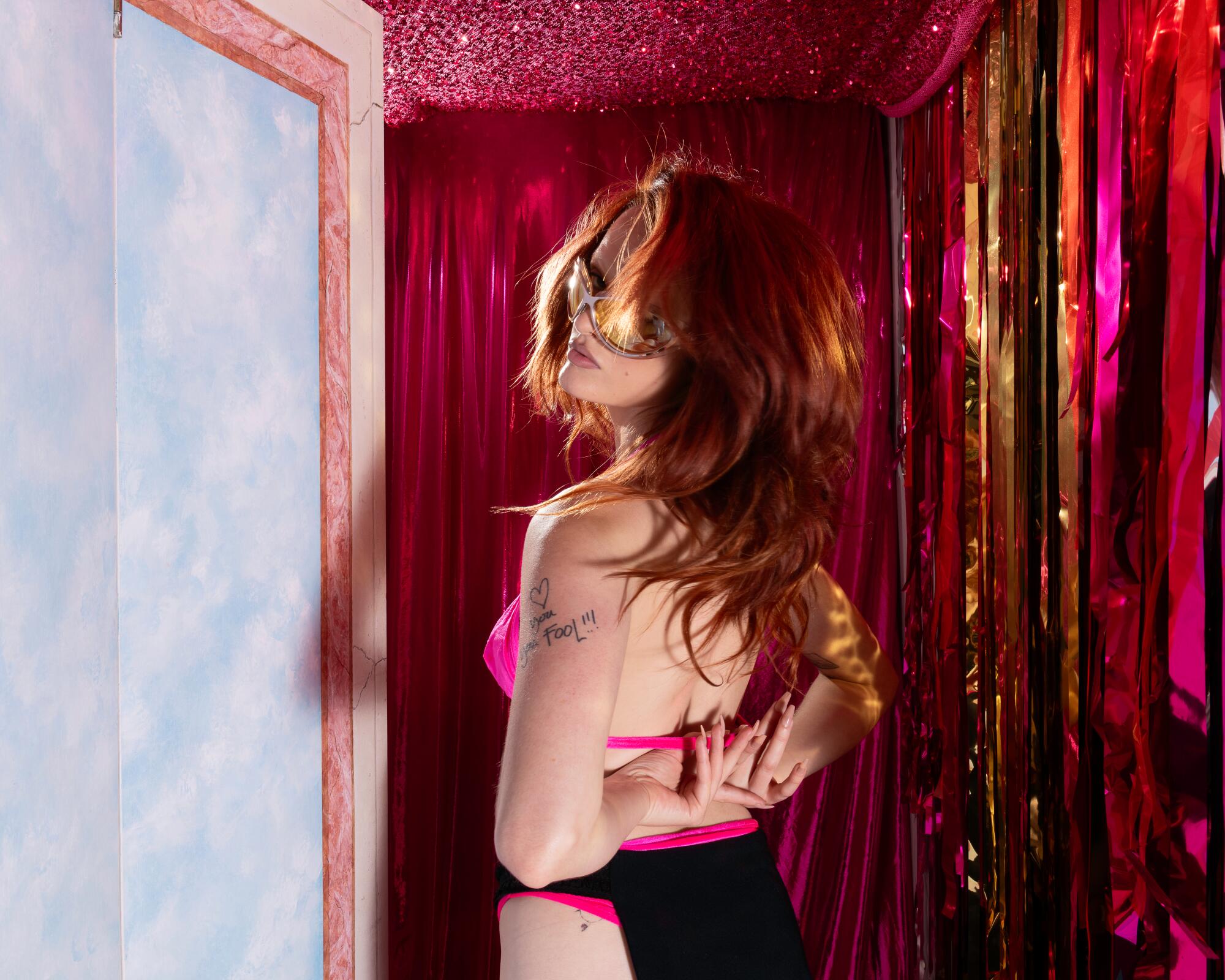
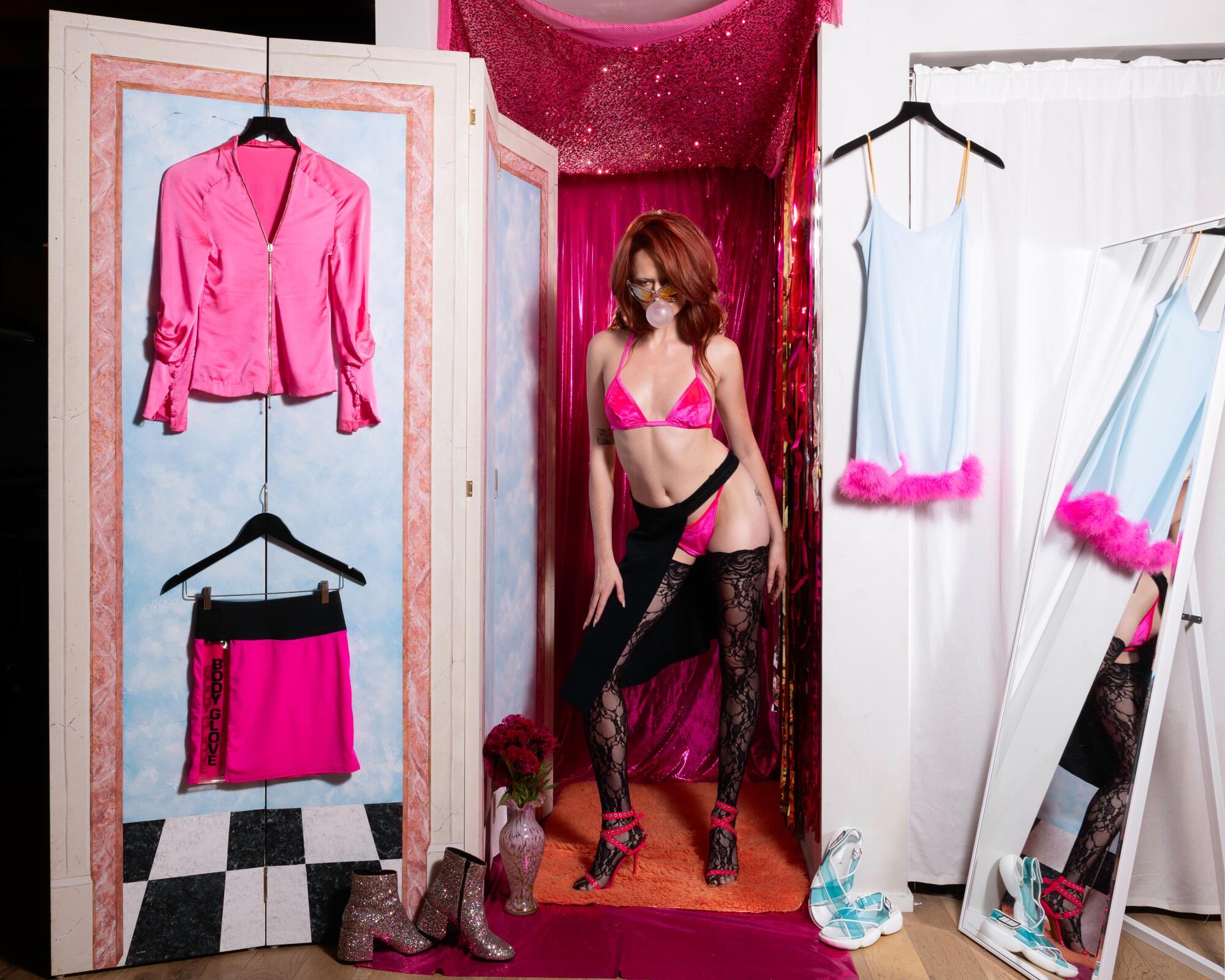
ED: You’ve focused on early aughts clothing for years now, but it’s interesting that so much of what we see on runways now references that decade as well, and even the 2010s. Why do you think so many brands today are referencing that era?
CJW: That decade featured pieces that were wearable but luxurious. It wasn’t just about big, crazy avant-garde things. It was about bodies.
BVG: In the 2010s everyone started getting into Rick Owens and Comme des Garçons that are really amazing sculptures, but you’re basically just wearing a shape. But in the early 2000s, it was just like, bodies! Showing off your Madonna arms.
CJW: Midriffs out!
BVG: But maybe it’s also because there’s something about our culture today shifting into more body positivity. Everyone was so insanely thin back then, but maybe now, we’re recontextualizing that era and saying, this is what it can be like if people loved their bodies and were showing their midriffs and having an ass. Because that’s what those clothes were really made for. And you see them on the runways now, and it’s similar but it’s different in a positive way, because brands are showing things on models who are all different shapes and sizes and ages.
CJW: You can take ideas from that era, when it was all skinny white ladies on the runways, put them on different people, and it becomes a whole new thing.
ED: Collin, how has your background as a librarian influenced your work in fashion? I feel like there’s a connection around the cataloging of knowledge.
CJW: I always worked in public libraries, so it actually wasn’t so much research, it was more customer service, helping people find what they’re looking for, which in a retail setting is what you’re doing all day. It’s about asking the right questions, which was weirdly a large part of my library work too. People might ask for something, but they don’t necessarily know what they really want. Not everyone knows how to explain what they’re looking for. So they start somewhere, like asking if we have any short dresses. It’s about asking questions to get at what they really want, because we know they don’t want just any short dress. Where are you wearing it to? What are you into? It’s getting to know people through specific interactions.
ED: It’s about knowing the steps to help them narrow down their search from a short dress to, say, a short chiffon floral dress that can be worn at a funeral [laughter].
BVG: Oh, that would totally be Dries Van Noten! Dries does a great sad floral.
ED: OK, wow, that was amazing — Dries really does do a great sad floral! I never would have thought of that. Let’s talk about sustainability, which is something fashion designers are asked about all the time, but rarely do vintage sellers get to talk about this. You’re in such a unique position because vintage dealers are often checking off each box in the three R’s of recycling: reduce, reuse, recycle.
From LAFW to Patrisse Cullors’ exhibit at the Fowler Museum to Saint Laurent’s new store, the Drip Index knows what you need this fall.
BVG: Thrifting is how I’ve always shopped. There are many reasons why, but a huge part of it is because it’s environmentally better. When we started, we actually designed clothes made out of existing garments. We’d go to the Goodwill and find like 800 white button-downs.
CJW: Or single-use T-shirts that are printed for some event that you’re never going to wear again after the 5K you just ran. There’s just so much of it. What can we do with that?
BVG: That’s definitely something we’ve always wanted to incorporate into our business, designing garments in small collections out of already existing pieces. Though there’s of course also the question, am I creating something that’s actually going to be worn regularly, or am I creating yet another thing that’s just going to go into a landfill? We don’t have the time to do it right now anyway, but that’s where I can see ourselves growing as a business. I do feel like there are a lot of people doing it and doing it well, like Conner Ives and All-In. Our L.A. store will have more space so we can feature garments by people who we think are doing it right.
ED: Tell me about the new store in L.A. What drew you to the city?
CJW: Our new store is in the Mandarin Plaza in Los Angeles. It’s very similar to the NYC store except it’s a lot larger and has a ton of natural light and plants everywhere.
BVG: For me, I really needed the mental space and the time. New York is so inspiring — you don’t have time to second guess anything. You’re constantly just going. I feel like I blinked and suddenly so many things have happened, I’ve woken up, I’m in my mid-30s. And as one does, you come to California to chill the f— out. Of course, we’re not actually chilling out — we’re opening a new store! But I just wanted to stop and think, what makes me happy? And it’s this business, creating and curating a store space, and as always, cultivating a community. That’s what makes me happy.
CJW: I feel like we can be so much more creative here, just thinking about setting up the larger store space. There’s sunlight and more room and high ceilings and this big table where I can work and sew and do all the things that I literally can’t physically do in New York because your life is piled on top of itself. You’re always digging yourself out from under things. Everything is just bigger and more open here, which is really exciting creatively.
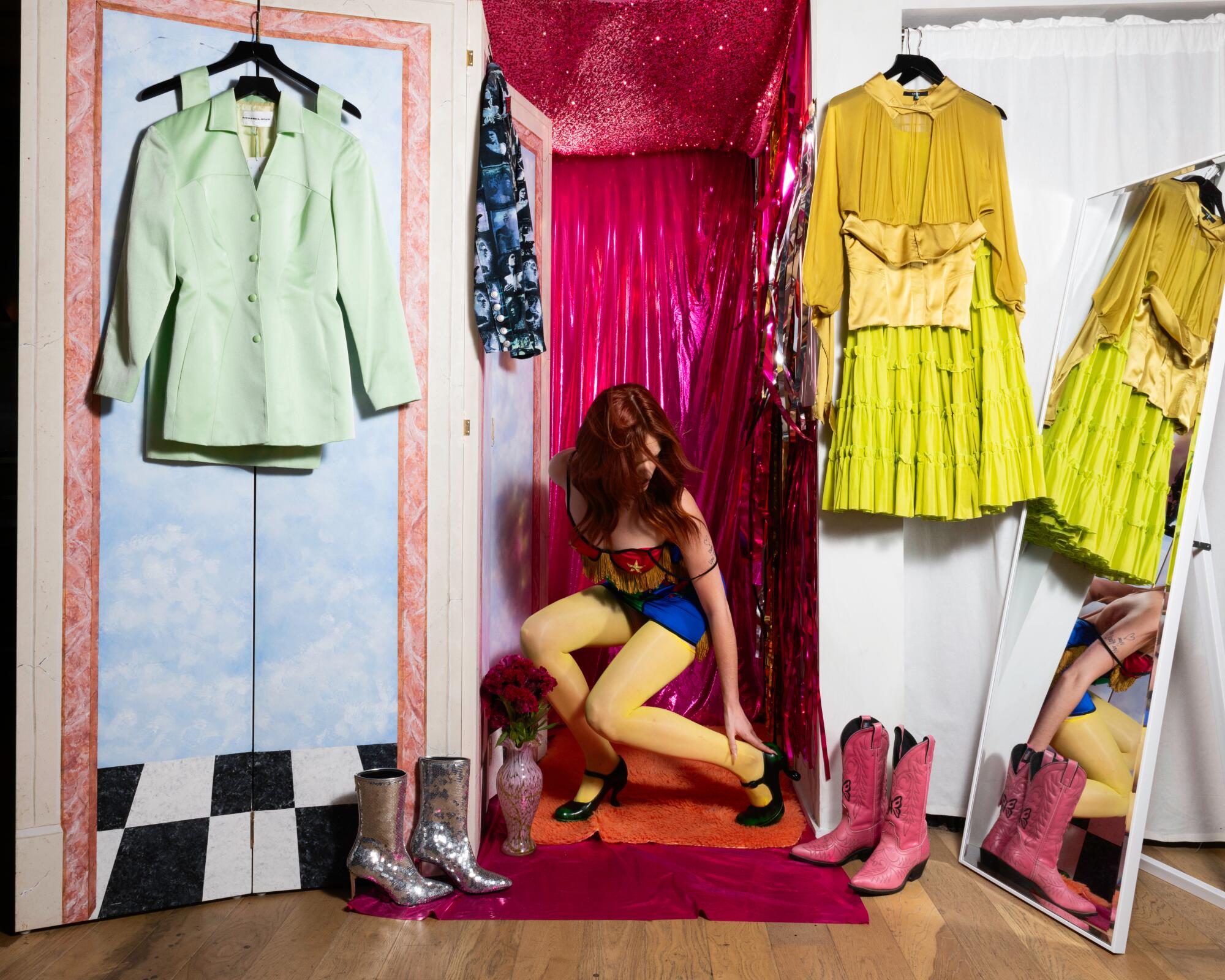
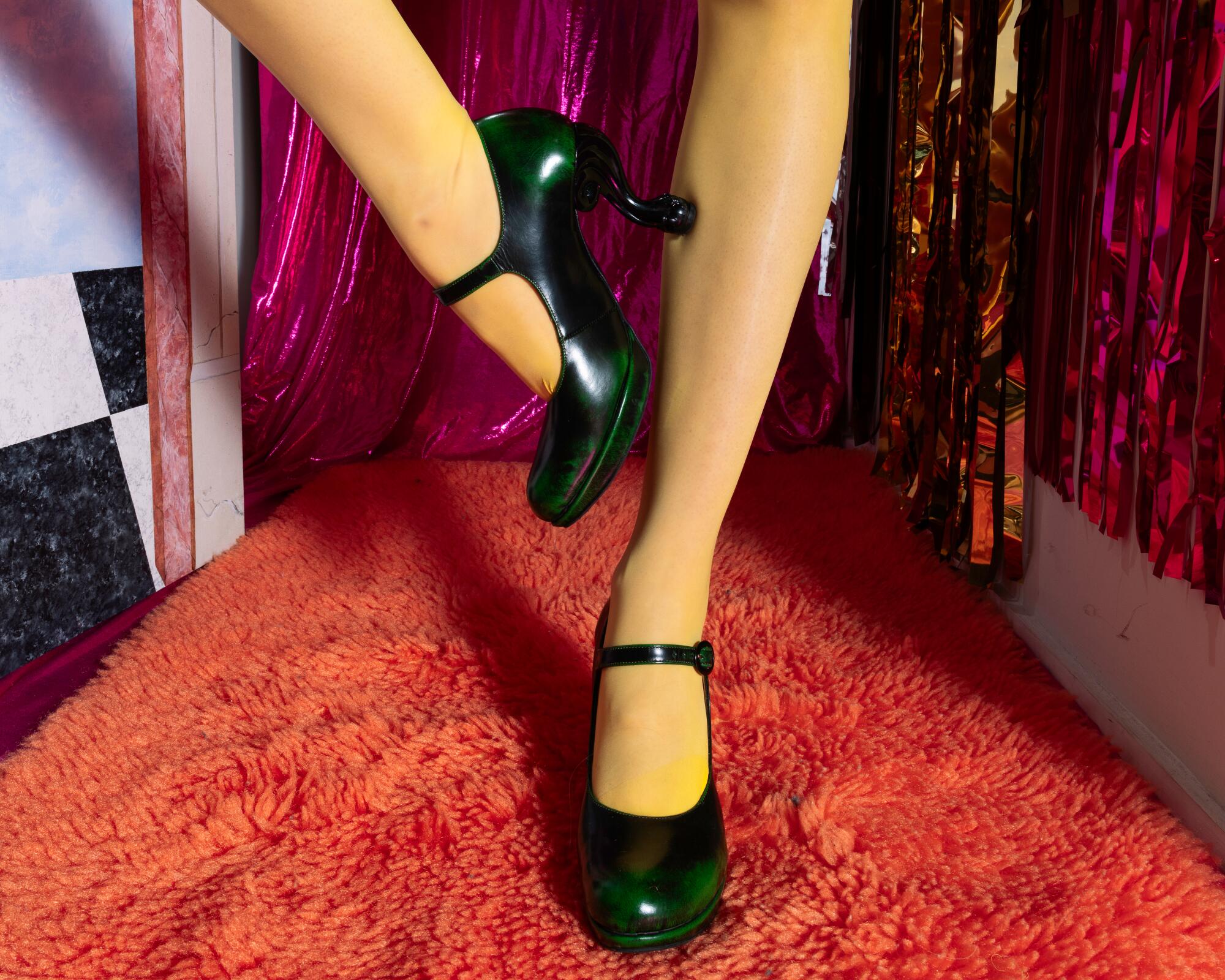
Model: Lucia Foshee
Makeup: Eden Lattanzio
Hair: Belen Gomez
Eugenie Dalland is a writer based in New York. Her essays, profiles, and reviews have appeared in the Los Angeles Review of Books, BOMB, and the Brooklyn Rail. She publishes the arts and culture magazine Riot of Perfume.
